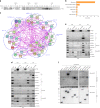Nuclear PTEN safeguards pre-mRNA splicing to link Golgi apparatus for its tumor suppressive role
- PMID: 29921876
- PMCID: PMC6008332
- DOI: 10.1038/s41467-018-04760-1
Nuclear PTEN safeguards pre-mRNA splicing to link Golgi apparatus for its tumor suppressive role
Abstract
Dysregulation of pre-mRNA alternative splicing (AS) is closely associated with cancers. However, the relationships between the AS and classic oncogenes/tumor suppressors are largely unknown. Here we show that the deletion of tumor suppressor PTEN alters pre-mRNA splicing in a phosphatase-independent manner, and identify 262 PTEN-regulated AS events in 293T cells by RNA sequencing, which are associated with significant worse outcome of cancer patients. Based on these findings, we report that nuclear PTEN interacts with the splicing machinery, spliceosome, to regulate its assembly and pre-mRNA splicing. We also identify a new exon 2b in GOLGA2 transcript and the exon exclusion contributes to PTEN knockdown-induced tumorigenesis by promoting dramatic Golgi extension and secretion, and PTEN depletion significantly sensitizes cancer cells to secretion inhibitors brefeldin A and golgicide A. Our results suggest that Golgi secretion inhibitors alone or in combination with PI3K/Akt kinase inhibitors may be therapeutically useful for PTEN-deficient cancers.
Conflict of interest statement
The authors declare no competing interests.
Figures







Similar articles
-
PTEN arginine methylation by PRMT6 suppresses PI3K-AKT signaling and modulates pre-mRNA splicing.Proc Natl Acad Sci U S A. 2019 Apr 2;116(14):6868-6877. doi: 10.1073/pnas.1811028116. Epub 2019 Mar 18. Proc Natl Acad Sci U S A. 2019. PMID: 30886105 Free PMC article.
-
A neuron-specific splicing switch mediated by an array of pre-mRNA repressor sites: evidence of a regulatory role for the polypyrimidine tract binding protein and a brain-specific PTB counterpart.RNA. 1997 Sep;3(9):996-1015. RNA. 1997. PMID: 9292499 Free PMC article.
-
Splicing misplaced.Cell. 2005 Aug 12;122(3):317-8. doi: 10.1016/j.cell.2005.07.016. Cell. 2005. PMID: 16096050 Review.
-
Neddylation of PTEN regulates its nuclear import and promotes tumor development.Cell Res. 2021 Mar;31(3):291-311. doi: 10.1038/s41422-020-00443-z. Epub 2020 Dec 9. Cell Res. 2021. PMID: 33299139 Free PMC article.
-
Nuclear organization of pre-mRNA splicing factors.Curr Opin Cell Biol. 1999 Jun;11(3):372-7. doi: 10.1016/S0955-0674(99)80052-0. Curr Opin Cell Biol. 1999. PMID: 10395556 Review.
Cited by
-
Recent advances in PTEN signalling axes in cancer.Fac Rev. 2020 Dec 23;9:31. doi: 10.12703/r/9-31. eCollection 2020. Fac Rev. 2020. PMID: 33659963 Free PMC article. Review.
-
Nuclear PTEN's Functions in Suppressing Tumorigenesis: Implications for Rare Cancers.Biomolecules. 2023 Jan 30;13(2):259. doi: 10.3390/biom13020259. Biomolecules. 2023. PMID: 36830628 Free PMC article. Review.
-
DNA methylation-regulated QPCT promotes sunitinib resistance by increasing HRAS stability in renal cell carcinoma.Theranostics. 2019 Aug 14;9(21):6175-6190. doi: 10.7150/thno.35572. eCollection 2019. Theranostics. 2019. PMID: 31534544 Free PMC article.
-
AKT1-CREB stimulation of PDGFRα expression is pivotal for PTEN deficient tumor development.Cell Death Dis. 2021 Feb 10;12(2):172. doi: 10.1038/s41419-021-03433-0. Cell Death Dis. 2021. PMID: 33568640 Free PMC article.
-
The Golgi Apparatus as an Anticancer Therapeutic Target.Biology (Basel). 2023 Dec 19;13(1):1. doi: 10.3390/biology13010001. Biology (Basel). 2023. PMID: 38275722 Free PMC article. Review.
References
Publication types
MeSH terms
Substances
LinkOut - more resources
Full Text Sources
Other Literature Sources
Molecular Biology Databases
Research Materials

